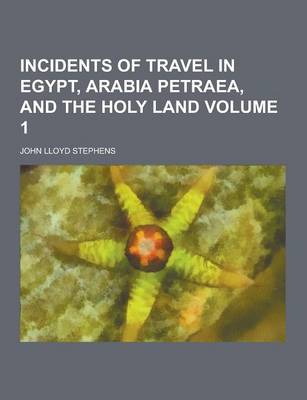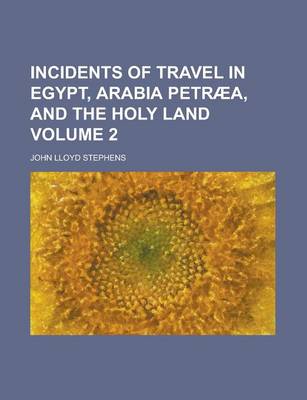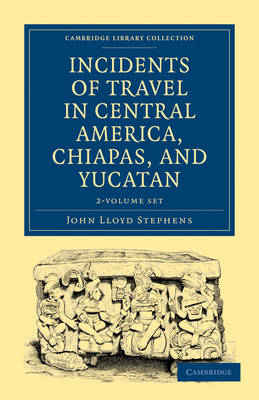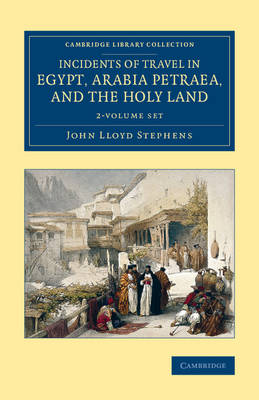Cambridge Library Collection - Archaeology
3 primary works • 5 total works
Volume 1
Incidents of Travel in Central America, Chiapas, and Yucatan
by John Lloyd Stephens
Published 9 February 2010
John Lloyd Stephens (1805–1852) was an American politician, explorer and writer who is renowned for his pioneering research into the ancient Maya civilisation of Central America. In 1839 Stephens was appointed a Special Ambassador to the Federal Republic of Central America (modern Belize, Honduras, Nicaragua, Guatemala and El Salvador). First published in 1841, this two-volume work is an account of his travels in 1839 and 1840, visiting and recording ancient Mayan sites. Stephens describes Copán, Palenque and forty-two other ancient sites and includes over fifty illustrations drawn by his travelling companion Frederick Catherwood (1799–1854), a professional architect. Although earlier accounts of Mayan ruins had been published, Stephens' vivid descriptions and Catherwood's meticulous drawings were far more detailed and accurate than previous reports, and kindled Victorian interest in the ancient Maya civilisation. Volume 1 focuses on Copán and the indigenous cultures of Central America.
Volume 1
Incidents of Travel in Egypt, Arabia Petraea, and the Holy Land Volume 1
by John Lloyd Stephens
Published 31 December 2009
The American writer and diplomat John Lloyd Stephens (1805-52) was effectively the founder of Mesoamerican archaeology, through his rediscovery of the Mayan civilization (his two-volume Incidents of Travel in Central America, Chiapas, and Yucatan is also reissued in this series). But before that, having qualified and practised as a lawyer in New York, he went on a two-year journey through Egypt and the Near East, publishing an account of his experiences in 1837 (under the name of George Stephens): this reissue is of the expanded 1838 edition. The work was extremely popular, possibly because, as he states in the preface, Stephens writes 'without perplexing himself with any deep speculations upon the rise and fall of empires', nor does he give much archaeological detail. Volume 1 begins with Stephens' arrival at Alexandria in Egypt, and his journey down the Nile to the Cataracts; it ends with a visit to St Catherine's monastery in Sinai.
Volume 2
Incidents of Travel in Egypt, Arabia Petraea, and the Holy Land Volume 2
by John Lloyd Stephens
Published 10 January 2010
The American writer and diplomat John Lloyd Stephens (1805-52) was effectively the founder of Mesoamerican archaeology, through his rediscovery of the Mayan civilization (his two-volume Incidents of Travel in Central America, Chiapas, and Yucatan is also reissued in this series). But before that, having qualified and practised as a lawyer in New York, he went on a two-year journey through Egypt and the Near East, publishing an account of his experiences in 1837 (under the name of George Stephens): this reissue is of the expanded 1838 edition. The work was extremely popular, possibly because, as he states in the preface, Stephens writes 'without perplexing himself with any deep speculations upon the rise and fall of empires', nor does he give much archaeological detail. Volume 2 sees Stephens heading towards Aqaba, whence he moves northward, visiting Petra, Gaza, Hebron, Jerusalem and the Dead Sea before returning to the coast at Tyre and sailing back to Alexandria.
Incidents of Travel in Central America, Chiapas, and Yucatan 2 Volume Set
by John Lloyd Stephens
Published 26 August 2010
John Lloyd Stephens (1805-1852) was an American politician, explorer and writer who is renowned for his pioneering research into the ancient Maya civilisation of Central America. In 1839 Stephens was appointed a Special Ambassador to the Federal Republic of Central America (modern Belize, Honduras, Nicaragua, Guatemala and El Salvador). First published in 1841, this two-volume work is an account of his travels in 1839 and 1840, visiting and recording ancient Mayan sites. Stephens describes Copan, Palenque and forty-two other ancient sites and includes over fifty illustrations drawn by his travelling companion Frederick Catherwood (1799-1854), a professional architect. Although earlier accounts of Mayan ruins had been published, Stephens' vivid descriptions and Catherwood's meticulous drawings were far more detailed and accurate than previous reports, and kindled Victorian interest in the ancient Maya civilisation.
Incidents of Travel in Egypt, Arabia Petraea, and the Holy Land 2 Volume Set
by John Lloyd Stephens
Published 5 March 2015
The American writer and diplomat John Lloyd Stephens (1805-52) was effectively the founder of Mesoamerican archaeology, through his rediscovery of the Mayan civilization (his two-volume Incidents of Travel in Central America, Chiapas, and Yucatan is also reissued in this series). But before that, having qualified and practised as a lawyer in New York, he went on a two-year journey through Egypt and the Near East, publishing an account of his experiences in 1837 (under the name of George Stephens): this reissue is of the expanded 1838 edition. The work was extremely popular, possibly because, as he states in the preface, Stephens writes 'without perplexing himself with any deep speculations upon the rise and fall of empires', nor does he give much archaeological detail. He intends to show the bustling New World what scenes are 'now passing in the faded and worn-out kingdoms of the Old World', involving travel in areas previously unknown to Western explorers.




